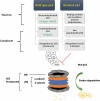Harnessing the vulnerabilities of p53 mutants in lung cancer - Focusing on the proteasome: a new trick for an old foe?
- PMID: 32041464
- PMCID: PMC7515531
- DOI: 10.1080/15384047.2019.1702403
Harnessing the vulnerabilities of p53 mutants in lung cancer - Focusing on the proteasome: a new trick for an old foe?
Abstract
Gain-of-function (GOF) p53 mutations occur commonly in human cancer and lead to both loss of p53 tumor suppressor function and acquisition of aggressive cancer phenotypes. The oncogenicity of GOF mutant p53 is highly related to its abnormal protein stability relative to wild type p53, and overall stoichiometric excess. We provide an overview of the mechanisms of dysfunction and abnormal stability of GOF p53 specifically in lung cancer, the leading cause of cancer-related mortality, where, depending on histologic subtype, 33-90% of tumors exhibit GOF p53 mutations. As a distinguishing feature and oncogenic mechanism in lung and many other cancers, GOF p53 represents an appealing and cancer-specific therapeutic target. We review preclinical evidence demonstrating paradoxical depletion of GOF p53 by proteasome inhibitors, as well as preclinical and clinical studies of proteasome inhibition in lung cancer. Finally, we provide a rationale for a reexamination of proteasome inhibition in lung cancer, focusing on tumors expressing GOF p53 alleles.
Keywords: P53 mutation; gain-of-function; lung cancer; proteasome; proteasome inhibitors; stability.
Figures


Similar articles
-
Plakoglobin restores tumor suppressor activity of p53R175H mutant by sequestering the oncogenic potential of β-catenin.Cancer Sci. 2018 Jun;109(6):1876-1888. doi: 10.1111/cas.13612. Epub 2018 May 23. Cancer Sci. 2018. PMID: 29660231 Free PMC article.
-
The oncogenicity of tumor-derived mutant p53 is enhanced by the recruitment of PLK3.Nat Commun. 2021 Jan 29;12(1):704. doi: 10.1038/s41467-021-20928-8. Nat Commun. 2021. PMID: 33514736 Free PMC article.
-
Addiction of lung cancer cells to GOF p53 is promoted by up-regulation of epidermal growth factor receptor through multiple contacts with p53 transactivation domain and promoter.Oncotarget. 2016 Mar 15;7(11):12426-46. doi: 10.18632/oncotarget.6998. Oncotarget. 2016. PMID: 26820293 Free PMC article.
-
Lung-Enriched Mutations in the p53 Tumor Suppressor: A Paradigm for Tissue-Specific Gain of Oncogenic Function.Mol Cancer Res. 2019 Jan;17(1):3-9. doi: 10.1158/1541-7786.MCR-18-0357. Epub 2018 Sep 17. Mol Cancer Res. 2019. PMID: 30224539 Free PMC article. Review.
-
Gain-of-function mutant p53 in cancer progression and therapy.J Mol Cell Biol. 2020 Sep 1;12(9):674-687. doi: 10.1093/jmcb/mjaa040. J Mol Cell Biol. 2020. PMID: 32722796 Free PMC article. Review.
Cited by
-
Could Oxidative Stress Play a Role in the Development and Clinical Management of Differentiated Thyroid Cancer?Cancers (Basel). 2023 Jun 14;15(12):3182. doi: 10.3390/cancers15123182. Cancers (Basel). 2023. PMID: 37370792 Free PMC article. Review.
-
HBB as a Novel Biomarker for the Diagnosis and Monitoring of Lung Cancer Regulates Cell Proliferation via ERK1/2 Pathway.Technol Cancer Res Treat. 2024 Jan-Dec;23:15330338241249032. doi: 10.1177/15330338241249032. Technol Cancer Res Treat. 2024. PMID: 38679728 Free PMC article.
-
Proteasome inhibition paradoxically degrades gain-of-function mutant p53 R273H in NSCLC and could have therapeutic implications.Front Oncol. 2024 Apr 10;14:1363543. doi: 10.3389/fonc.2024.1363543. eCollection 2024. Front Oncol. 2024. PMID: 38660140 Free PMC article.
-
Sensitive Electrochemical Biosensor for Rapid Screening of Tumor Biomarker TP53 Gene Mutation Hotspot.Biosensors (Basel). 2022 Aug 19;12(8):658. doi: 10.3390/bios12080658. Biosensors (Basel). 2022. PMID: 36005054 Free PMC article.
-
Therapeutic Targeting of P53: A Comparative Analysis of APR-246 and COTI-2 in Human Tumor Primary Culture 3-D Explants.Genes (Basel). 2023 Mar 19;14(3):747. doi: 10.3390/genes14030747. Genes (Basel). 2023. PMID: 36981018 Free PMC article.
References
-
- World Health Organization . Cancer. [accessed 2019. July 13]. https://www.who.int/news-room/fact-sheets/detail/cancer.
-
- Lynch TJ, Bell DW, Sordella R, Gurubhagavatula S, RA O, BW B, Harris PL, Haserlat SM, Supko JG, Haluska FG, et al. Activating mutations in the epidermal growth factor receptor underlying responsiveness of non–small-cell lung cancer to gefitinib. N Engl J Med. 2004;350:2129–2139. doi:10.1056/NEJMoa040938. - DOI - PubMed
Publication types
MeSH terms
Substances
Grants and funding
LinkOut - more resources
Full Text Sources
Medical
Research Materials
Miscellaneous
